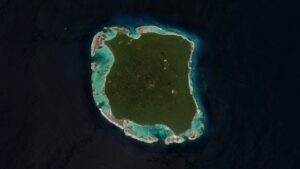If you journey to the center of the Earth, you’ll run into a 1,300km-wide ball of solid iron — after you get through another inner core with somewhat different properties.
That’s the news following one research team’s recent findings, published in the journal Nature Communications. Their portrait of Earth’s “innermost inner core” splits from conventional wisdom, which holds that the planet has four layers — the crust, the mantle, the outer core, and the inner core. In the new findings, there are five, including that solid ball inside the inner core.
The team measured seismic activity at multiple earthquake sites at opposite points on Earth to compile its data. It found that seismic waves passing through an innermost segment of mostly iron and nickel ore behaved slightly differently than they did in the layer just above it.
“Our findings strengthen the evidence for an anisotropically-distinctive innermost inner core and its transition to a weakly anisotropic outer shell, which could be a fossilized record of a significant global event from the past,” the researchers wrote.
The inner core of the Earth appears to hold an innermost secret.
Two Australian scientists argue in a new paper that within the Earth’s core, based on measurements of waves reverberating along the Earth’s diameter, is an innermost inner core. https://t.co/U1z0v7Wsgq
— The New York Times (@nytimes) February 24, 2023
A hard place to study
In layman’s terms, anisotropism causes a material to behave differently under impact, depending on the direction of this impact. Imagine splitting firewood: a log splits if you hit it with the grain, but it splinters if you hit it against the grain.
The new evidence for the fifth-core layer builds on a geophysical theory from the 1980s. It’s hard to study the inner core in detail because it’s buried under 2,900 vertical kilometers of varyingly molten rock and metal.
It’s also hard to set up locations on the earth where it’s possible to detect inner core activity at all. Stations need to be almost directly opposite each other on the globe. Researchers also need a particular type of earthquake to study the inner core that generally only occurs along the equator.
The inner core also helps power the earth’s magnetic field, and one co-author told CNN that this new study could teach us about the ancient histories of alien worlds.
“Take Mars as an example,” said Australian seismologist Thanh-Son Phạm. “We don’t understand yet why [Mars’ magnetic field] ceased to exist in the past.”






